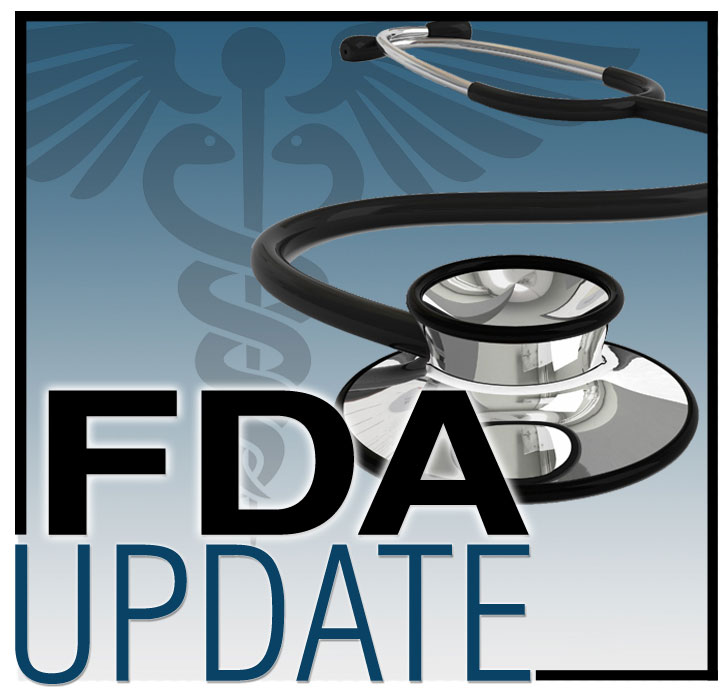FDA Approves Oral Combination of Decitabine and Cedazuridine for Myelodysplastic Syndromes
On July 7, 2020, the U.S. Food and Drug Administration (FDA) approved an oral combination (https://www.fda.gov/drugs/drug-approvals-and-databases/fda-approves-oral-combination-decitabine-and-cedazuridine-myelodysplastic-syndromes) of decitabine and cedazuridine (Inqovi®) for adult patients with myelodysplastic syndromes (MDS), including the following:

- Previously treated and untreated, de novo and secondary MDS with the following French-American-British subtypes: refractory anemia, refractory anemia with ringed sideroblasts, refractory anemia with excess blasts, and chronic myelomonocytic leukemia (CMML)
- Intermediate 1, intermediate 2, and high-risk international prognostic scoring system (IPSS) groups
The combination of decitabine and cedazuridine was investigated in two open-label, randomized, crossover trials. One trial (ASTX727-01-B; NCT02103478) included 80 adult patients with MDS (IPSS intermediate 1, intermediate 2, or high-risk) or CMML. The second trial (ASTX727-02; NCT03306264) included 133 adult patients with MDS or CMML, including all French-American-British classification criteria and IPSS intermediate 1, intermediate 2, or high-risk disease.
In both trials, patients were randomized 1:1 to receive decitabine and cedazuridine (35 mg decitabine and 100 mg cedazuridine) orally in cycle 1 and decitabine 20 mg/m2 via IV in cycle 2 or the reverse sequence. Both the combination treatment and IV decitabine alone were administered once daily on days 1–5 of a 28-day cycle. Starting with cycle 3, all patients received decitabine and cedazuridine orally once daily on days 1–5 of each 28-day cycle until patients experienced disease progression or unacceptable toxicity.
Both trials compared exposure and safety in the first two cycles between oral decitabine and cedazuridine and IV decitabine and described disease response with decitabine and cedazuridine. The disease response could not be compared between the decitabine and cedazuridine and IV decitabine because all patients received decitabine and cedazuridine starting in cycle 3.
The 01-B trial demonstrated a complete response (CR) rate of 18% (95% CI = 10, 28), and the median duration of CR was 8.7 months (range = 1.1, 18.2). Among the 41 patients who were dependent on red blood cell (RBC) or platelet transfusions at baseline, 20 (49%) became independent of RBC and platelet transfusions during any consecutive 56-day postbaseline period. Of the 39 patients who were independent of both RBC and platelet transfusions at baseline, 25 (64%) remained transfusion-independent during any consecutive 56-day postbaseline period.
The 02 trial demonstrated a 99% (90% CI = 93, 106) geometric mean ratio of the five-day cumulative decitabine area under curve following five consecutive daily doses of decitabine and cedazuridine compared to that of IV decitabine. Efficacy results demonstrated that 21% of patients achieved CR (95% CI = 15, 29) and that the median duration of CR was 7.5 months (range = 1.6, 17.5). Among the 57 patients who were dependent on RBC or platelet transfusions at baseline, 30 (53%) became independent of RBC and platelet transfusions during any 56-day postbaseline period. Of the 76 patients who were independent of both RBC and platelet transfusions at baseline, 63% remained transfusion-independent during any 56-day postbaseline period.
The most common adverse reactions (≥ 20%) were fatigue, constipation, hemorrhage, myalgia, mucositis, arthralgia, nausea, dyspnea, diarrhea, rash, dizziness, febrile neutropenia, edema, headache, cough, decreased appetite, upper respiratory tract infection, pneumonia, and increased transaminase.
The most common grade 3 or 4 laboratory abnormalities (≥ 50%) were decreases in leukocytes, platelet count, neutrophil count, and hemoglobin. The overall safety profile of oral decitabine and cedazuridine was similar to that of IV decitabine.
The recommended decitabine and cedazuridine dose is one tablet (35 mg decitabine and 100 mg cedazuridine) taken orally on an empty stomach once daily on days 1-5 of each 28‑day cycle.
The review used the Oncology Center of Excellence’s Assessment Aid (https://www.fda.gov/about-fda/oncology-center-excellence/assessment-aid) as well as the Office of Pharmaceutical Quality’s Assessment Aid for quality review. These are voluntary submissions from the applicant to facilitate FDA’s assessment.
FDA collaborated with international agency counterparts on the review of the application as part of Project Orbis (https://www.fda.gov/about-fda/oncology-center-excellence/project-orbis).
FDA granted the application priority review. A description of FDA expedited programs is in the Guidance for Industry—Expedited Programs for Serious Conditions—Drugs and Biologics (https://www.fda.gov/regulatory-information/search-fda-guidance-documents/expedited-programs-serious-conditions-drugs-and-biologics).
Healthcare professionals should report all serious adverse events suspected to be associated with the use of any medicine and device to FDA’s MedWatch Reporting System (https://www.accessdata.fda.gov/scripts/medwatch/index.cfm) or by calling 800-FDA-1088.
For assistance with single-patient oncology investigational new drug applications, contact the Oncology Center of Excellence’s Project Facilitate (https://www.fda.gov/about-fda/oncology-center-excellence/project-facilitate) at 240-402-0004 or email OncProjectFacilitate@fda.hhs.gov (mailto:OncProjectFacilitate@fda.hhs.gov).
